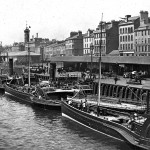 Named after the Brumelaw Croft, a stretch of land running along the north bank of the Clyde, the street known as the Broomielaw extends from Jamaica Bridge to Finnieston Quay. It was Glasgow merchant Walter Gibson, “the father of the trade of all the west coasts”, who financed the building of Glasgow’s first quay, at the Broomielaw in 1688. Significant progress in bringing shipping into the heart of Glasgow would have to wait until the Clyde was made more navigable and major obstacles such as the sandbank at Dumbuck cleared. By 1775, the channel from the Broomielaw to Dumbuck was almost 8 feet deep depending upon the tide. Europe’s first commercial steamer service in the form of Henry Bell’s “Comet” departed from the Broomielaw in 1812. It was the Scottish civil engineer, Thomas Telford who redesigned the Broomielaw quays to handle the busy steamboat traffic as thousands of immigrants came over from Ireland in the mid 19th Century to work in the new industries generated by the Industrial Revolution. Glasgow was becoming an industrial powerhouse.
Named after the Brumelaw Croft, a stretch of land running along the north bank of the Clyde, the street known as the Broomielaw extends from Jamaica Bridge to Finnieston Quay. It was Glasgow merchant Walter Gibson, “the father of the trade of all the west coasts”, who financed the building of Glasgow’s first quay, at the Broomielaw in 1688. Significant progress in bringing shipping into the heart of Glasgow would have to wait until the Clyde was made more navigable and major obstacles such as the sandbank at Dumbuck cleared. By 1775, the channel from the Broomielaw to Dumbuck was almost 8 feet deep depending upon the tide. Europe’s first commercial steamer service in the form of Henry Bell’s “Comet” departed from the Broomielaw in 1812. It was the Scottish civil engineer, Thomas Telford who redesigned the Broomielaw quays to handle the busy steamboat traffic as thousands of immigrants came over from Ireland in the mid 19th Century to work in the new industries generated by the Industrial Revolution. Glasgow was becoming an industrial powerhouse.
Many of the fine photographs in this chapter have been kindly provided by Graham Lappin and the rest are from my own collection.
The name Broomielaw was often associated with the wharves but they take their name from the street that runs behind them, on which traffic flowed to and from the quaysides. This 1910 scene shows the view looking west along the Broomielaw from the junction with Oswald Street. At that time, all the merchant traffic was horse-drawn. Many of the carts shown here are heavily laden and it must have been hard work for the horses to haul those loads over the cobblestones. The cart on the left belongs to the United Cooperative Baking Society Ltd., famous for its biscuits, some of which are probably packed in those containers destined for the steamers and their ports of call. On the right are several businesses including a café shaded by an awning and offering ice cream. Next door is a restaurant and then a bar, the Argyle Vaults. Clearly, a wide variety of refreshments would have been available to the steamboat passengers. Above the café and restaurant are the premises of the Edinburgh Roperie & Sailcloth Co. Ltd., a company founded by merchants in Edinburgh and Leith in 1750 to supply the maritime industry. The domed building on the corner with Robertson Street is a recent addition to the Clyde Navigation Trust building, having been completed in 1908 to a design by the noted architect J. J. Burnet. It survives as a Grade A listed structure today. ( From a Stereo view by Stereo-Travel Co., Corona, New York City. Courtesy of the Graham Lappin Collection. )
In this early 1880’s view by James Valentine looking east over the river from the tower of the Sailors’ Home, the steamer Dunoon Castle in her two-funnelled phase is just pulling away from her berth. Five bridges are visible spanning the Clyde and they are, from nearest the camera; the Caledonian Railway Bridge (completed 1879), Thomas Telford’s Glasgow Bridge (1836), the Suspension Bridge (1853), Victoria Bridge (1854) and the City of Glasgow Union Railway Bridge (1870). The Albert Bridge beyond, completed in 1871, is not visible. The stepped steeple on the left is the Merchant’s Steeple (1659) and on the right is the tall steeple of Gorbals Parish Church (1810). ( Courtesy of the Graham Lappin Collection )
In this scene, captured at least 15 years earlier in 1865 by Thomas Annan, part of the Broomielaw wharf is under construction. The vantage point is again the tower of Sailors’ Home and the railway bridges have not yet been built. The railway companies were still encountering stiff resistance in their efforts to span the Clyde in central Glasgow. The two-funnelled steamer in the picture is the Eagle which had just entered service the year before. ( Courtesy of the Graham Lappin Collection )
In this early morning scene, photographed by George Washington Wilson (GWW) in 1876, the stepped arrangement of the Broomielaw quays is clearly shown, permitting vessels to overlap and thus use the quayside space more economically. The steamer Windsor Castle is in the foreground and moored beside her is the Balmoral. Beyond are the Undine, Vesta and Eagle. The Guinevere and Carrick Castle are parked across the river. Early morning was clearly a good time of the day to work on the funnels, when they would have cooled down overnight. ( Courtesy of the Graham Lappin Collection )
The overlapping arrangement of the steamers is clearly shown in this George Washington Wilson photograph taken around 1870 and featuring from left to right, the Marquis of Bute, Lancelot and Sultana. The shed on the quayside is open and served as a shelter for passengers unlike the sheds further down which were enclosed and primarily intended for storage. Behind the shed, on the Broomielaw, is a Temperance Hotel and further down the street Murray’s Portrait Rooms occupy the top floor of a building and there is a studio on the roof. Commercial photography was becoming more accessible and was proving extremely popular with the public. The round tower in the distance is part of the Sailors’ Home at 150 Broomielaw and the vantage point for the first photographs in this series. The building was designed by John Rochead and opened in 1855/56. ( Courtesy of the Graham Lappin Collection )
In this wider view of the Broomielaw quayside taken around 1870, the steamers Eagle, Dunoon Castle ( in her early single funnel form ) and the Lancelot are featured from left to right. Beyond them, some sailing vessels are moored. The Glasgow Fish Market was located at the Broomielaw for nearly a hundred years, from 1755 to 1853, after which it was transferred up river to Glasgow Green between Albert Bridge and the Weir. ( Courtesy of the Graham Lappin Collection )
In this 1876 view by George Washington Wilson, the steamer Carrick Castle is reversing into her berth which is sandwiched between the quayside, the bow of the Marquis of Lorne and the stern of the Benmore. This would require considerable skill and the crew would be well-practiced. For manoevres such as this, it was certainly beneficial to have the wheel behind the funnel. ( Courtesy of the Graham Lappin Collection )
This photograph by George Washington Wilson shows the same three steamers as in the previous view now all at the quayside and filling up with passengers for the Clyde resorts. The Benmore usually sailed to Kilmun while the Carrick Castle was the regular Lochgoilhead steamer and the Marquis of Lorne sailed to Dunoon and Rothesay. These three steamers normally departed at different times of the day and so the fact that all three are boarding and in steam, ready to sail, suggests a special occasion such as a Fair Saturday or the following Monday. ( Courtesy of the Graham Lappin Collection )
This famous photograph by George Washington Wilson shows the Benmore leaving the Broomielaw packed with passengers on Fair Saturday morning in 1885 and bound for Kilmun on the Holy Loch. You can imagine the excitement on board as most of the passengers had probably been looking forward to this trip for months. Notice that the seaman at the wheel is having to lean far to the right so that he can see around the funnel. The steamer Meg Merrilies is at the quayside. ( Courtesy of the Graham Lappin Collection )
This scene, photographed by Thomas Annan in 1895, features the steamers Daniel Adamson and Benmore moored in the foreground and the Iona canting in midstream. One of the Clutha river ferries is passing by, heading for the Glasgow Bridge landing. This close up view of the Daniel Adamson shows that she is simply appointed with a rather spartan upper deck. There is a simple bench set behind the wheel and then a few benches for passengers arranged down the centre of the deck. There is also seating around the periphery, bolted onto the railings. There are no life rafts, only a lifebelt and a single lifeboat at the stern, and there are no ventilators present so it must have been quite stuffy below decks and particularly in the engine room. ( Postcard published by the Reliable Series. )
In this view, taken by Thomas Annan a few minutes after the previous scene, the Daniel Adamson is now leaving while the Iona is still positioning herself ready to reverse into her berth. More details are visible of the quayside where there are bales of hay stacked up and an area reserved for boarding the famed MacBrayne’s steamers, Columba and Iona. ( Postcard published by Raphael Tuck & Sons. )
In this 1897 scene, the steamer Victoria is in the foreground, reversing into her berth, and beyond is MacBrayne’s famed Iona. Both steamers were well-known but for completely different reasons. The Iona had been in service since 1865 and, when completed, she was the fastest and most comfortable steamer on the Clyde, the first to be fitted with deck saloons which extended nearly three-quarters of her length and afforded shelter for most of her passengers. Together with her famous stable mate, the Columba, she was renowned on the Firth and was the carrier of mail on the Royal Route as far as Ardrishaig. In contrast, the newer Victoria, completed in 1886, had a chequered history and, at the time this photograph was taken, was known as the Sabbath-breaking boat. Although she sailed every day of the week except Wednesday, it was her Sunday outings that caught the attention of the press and particularly her attempts to land passengers at Dunoon when the pier was closed to them. On several occasions, the Victoria’s passengers stormed the pier’s gates in an effort to enter the town. ( Courtesy of the Graham Lappin Collection )
The passengers are just getting settled on board the Isle of Cumbrae in this Edwardian scene, most likely photographed in 1904/5, soon after the steamer had entered service with Buchanan’s fleet. When new, she had been the Jeanie Deans, in service with the North British Railway and for many years was the fastest steamer on the Firth. Then, after a brief spell as the Duchess of York, she was purchased by Captain Buchanan and renamed the Isle of Cumbrae. She has a small deck astern, suitable for passengers who prefer less exposure. It is interesting to note the choices of seating on board; very simple slatted seating bolted onto the railings and providing poor back support, and much more robust benches that could probably do double duty as church pews. ( Part of a stereoview published by Underwood & Underwood, New York & London. )
This photograph taken much later, in 1911/12, also features the Isle of Cumbrae which has just left the quayside and is sounding her siren to warn traffic as she heads down river. Another Buchanan steamer, the Isle of Arran, is moored and Bryant & May’s famous “Swan Vestas” matches are advertised on the quayside shelter. ( Courtesy of the Graham Lappin Collection )
Two very fine steamers, the Ivanhoe which is departing and the Eagle III moored, are captured in this photo, taken sometime between 1912 and 1914. The beautifully appointed Ivanhoe was actually 30 years older than the Eagle, having been built in 1880, and was originally the temperance steamer under Captain James Williamson. However, temperance ultimately gave way to profits. There had been talk of falling receipts and when the steamer entered railway service with the Caledonian Steam Packet Co. in 1897, bars were installed in the lower saloons fore and aft and passengers were able to enjoy a “wee refreshment” during their journey. Prior to this, the “Ivanhoe” flask, which had found a ready sale in Glasgow, substituted for the purpose.
Legends © Christopher J. Jones
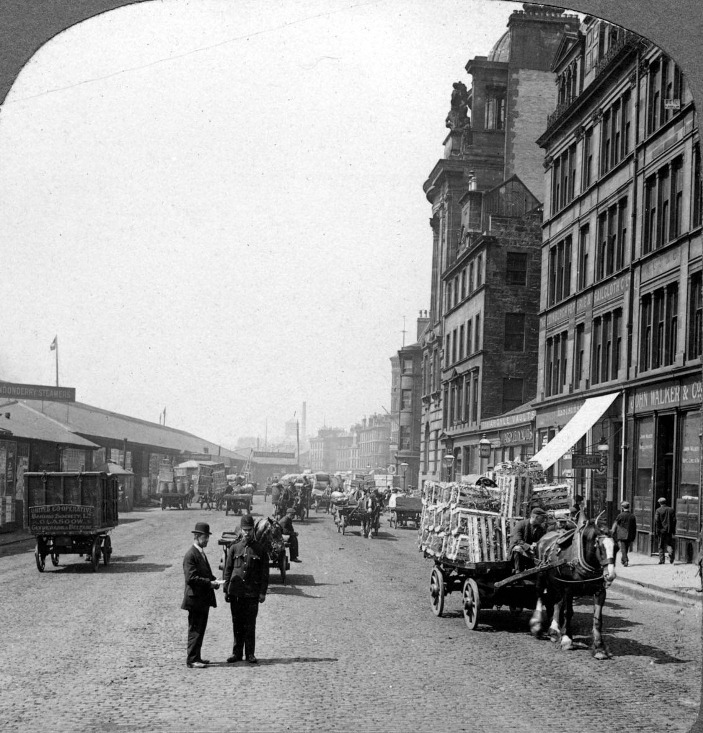
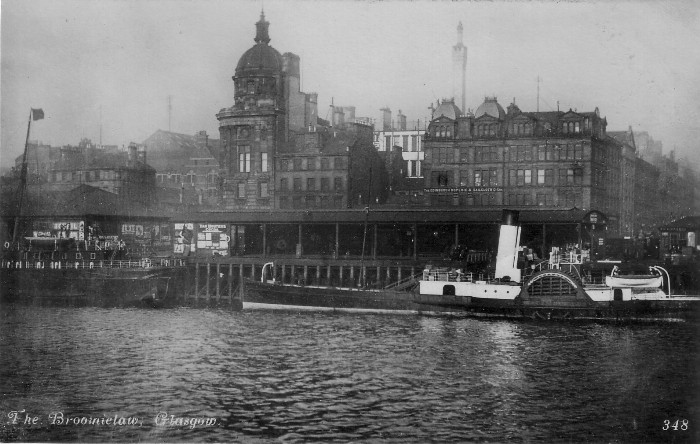
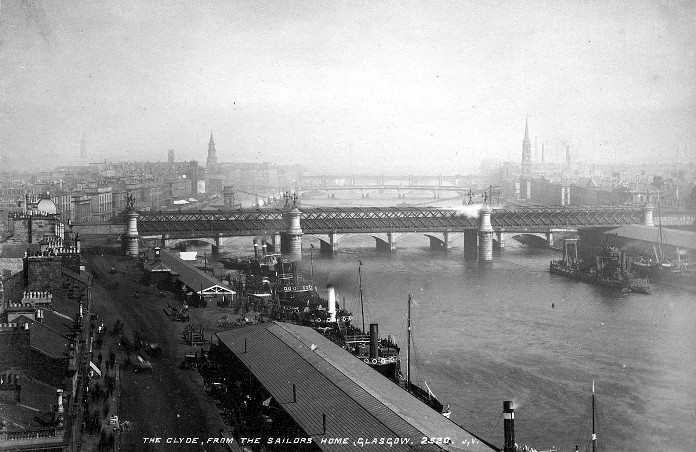
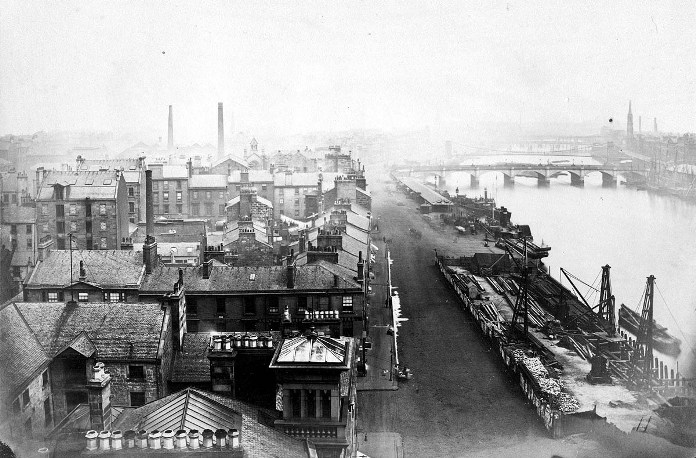
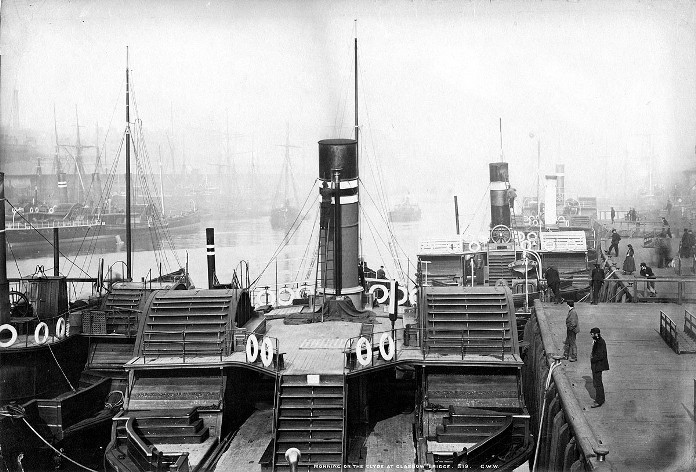
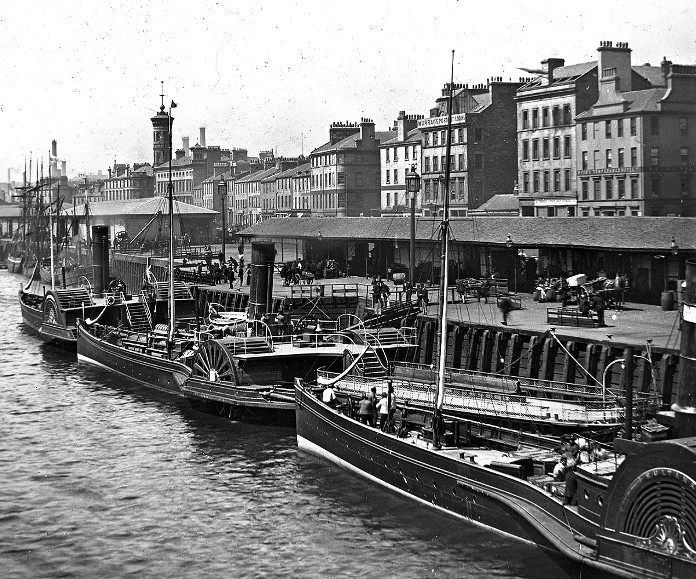
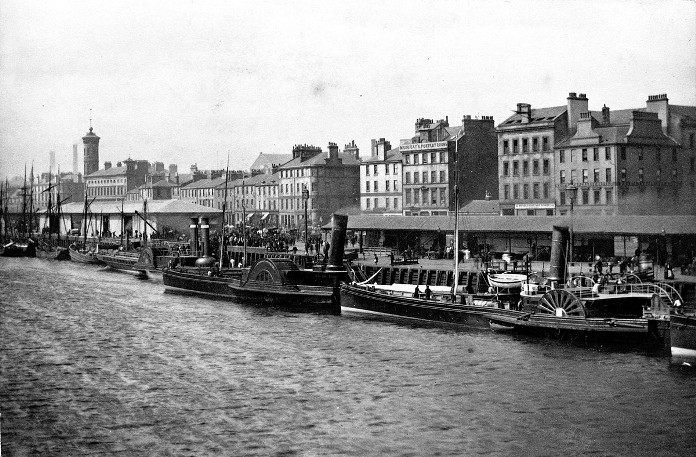
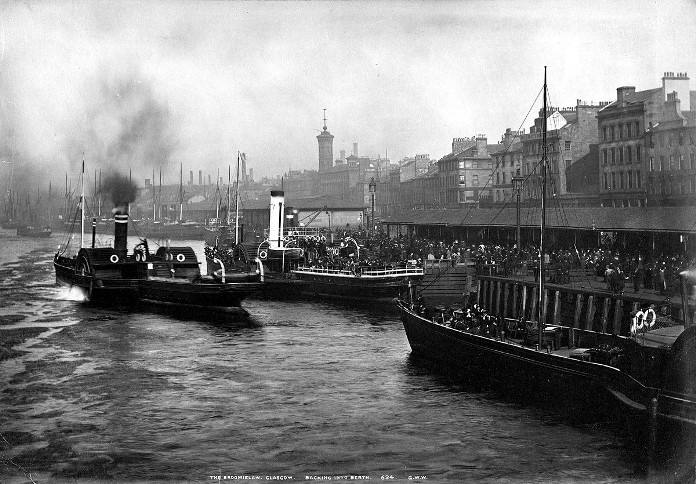
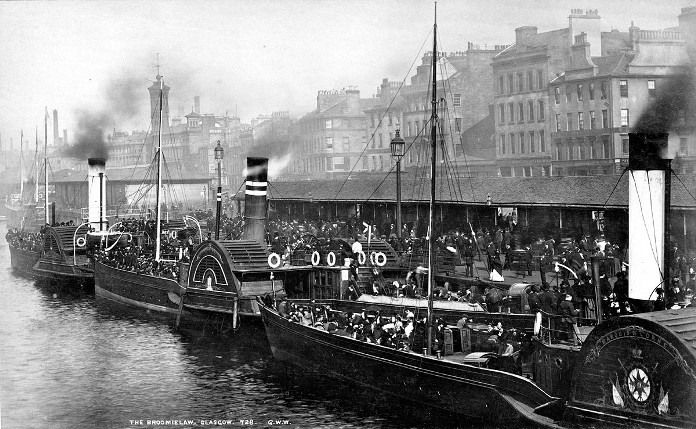
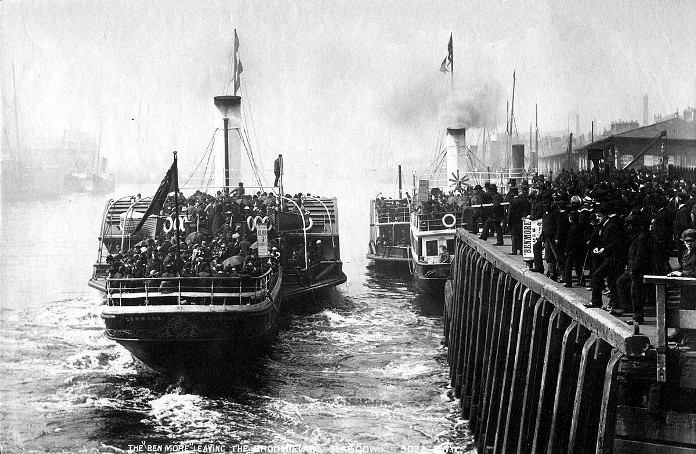
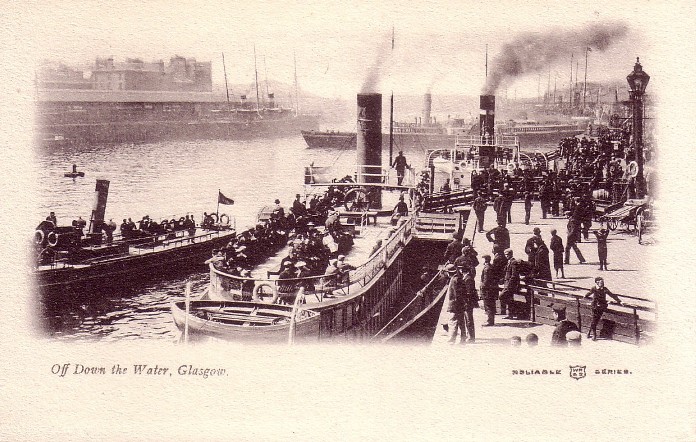
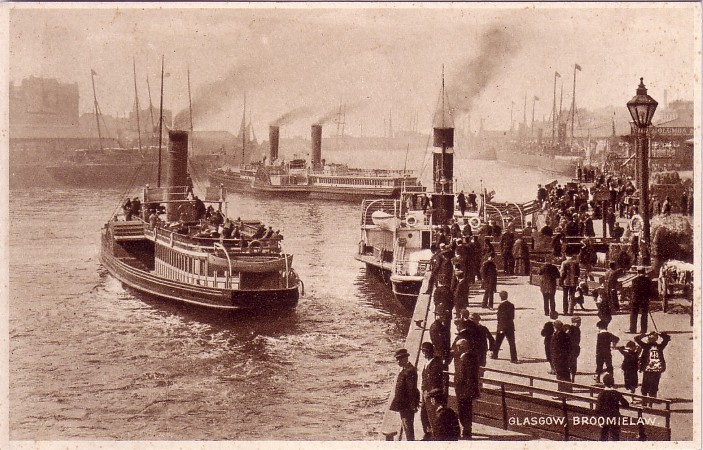
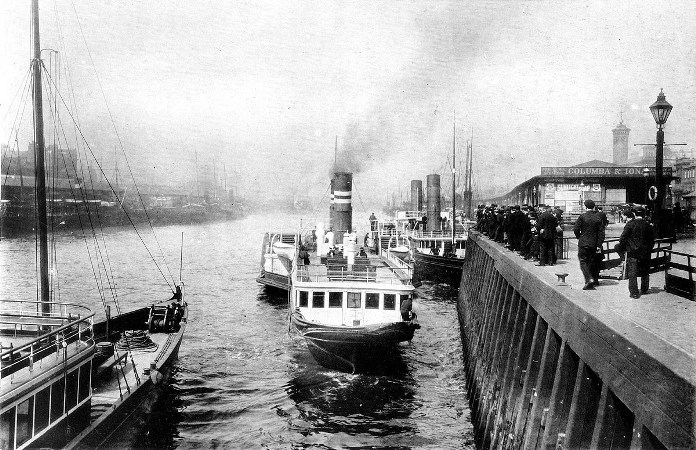
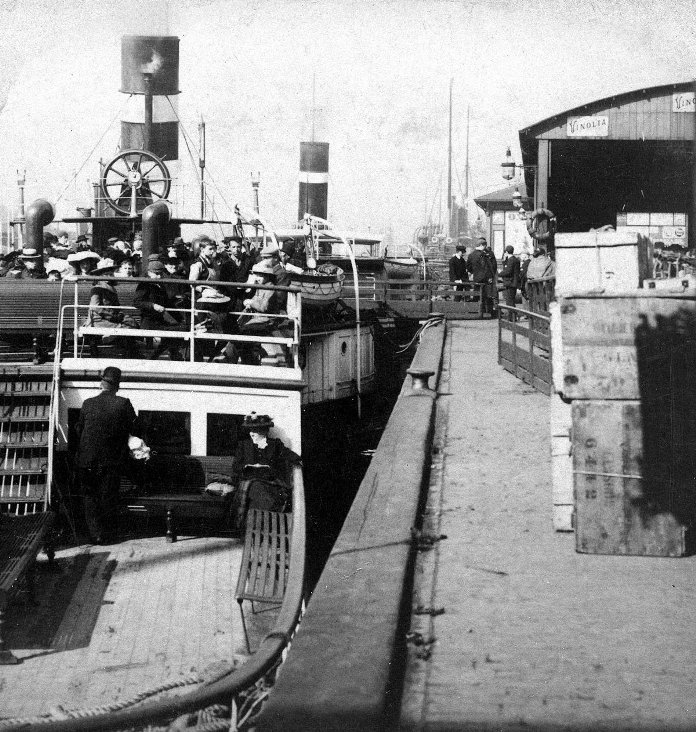
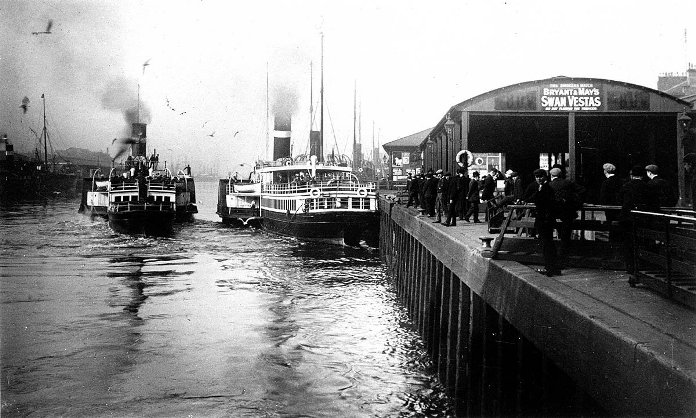
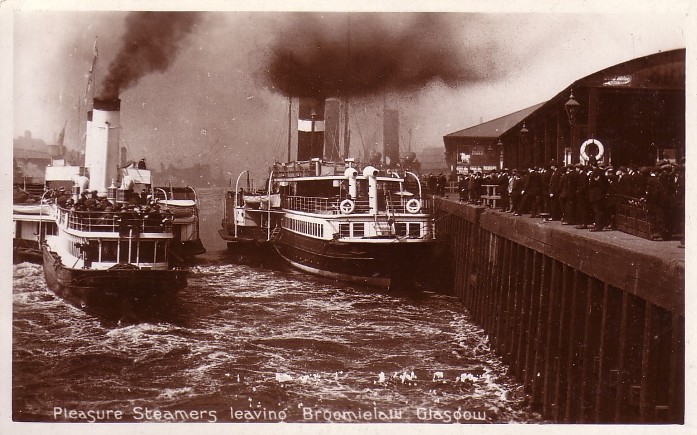

{ 3 trackbacks }
{ 77 comments… read them below or add one }
This is a great article with some fine photographs. I have just finished an article “Glasgow Time Signals: a Source of Friction with Edinburgh”, which will be published in the Journal of Astronomical History and Heritage in November 2010. Its focus is on the Glasgow time ball, which was on top of the Glasgow Sailors’ Home at 150 Broomielaw. It operated between 1858 and 1864, but was superseded by controlled clocks from 1864 onwards. It can be seen in its lowered position in several of the 1870s photographs, so it was clearly not removed for some years.
Regards
Dr Roger Kinns
Thank you Roger. As you know, we have been corresponding by e-mail and I look forward to the publication of your article.
I write books about Glasgow and wonder if you could put me in touch with Graham Lappin.
Thanks
Carol
Fascinating to find the pictures of the ‘Carrick Castle’ here – Capt. Willy Barr, her master and builder was a distant great-uncle of mine.
I am looking for any photos which show the bottle work cones which were there in Lancefield Street, Port Dundas and other places in Glasgow in the 19th Century; my ancestor John Little worked there for years as a bottlemaker – can anyone help? – Alison.
Thank you for your comment Alison. I’m impressed that you were able to trace a line of your family back to the master of the Carrick Castle, Captain William Barr, who indeed planned the vessel and supervised her construction. She was built at John Fullerton’s shipyard at Merksworth in Paisley in 1870.
I contacted Graham Lappin with respect to the bottle works in Lancefield Street and he discovered this photo in a biography of Robert Napier. Robert’s cousin David had moved his marine engineering business from Camlachie to larger premises in Lancefield around 1820 and Robert took over the operation in 1836. This photograph was taken later and shows the location of the engineering premises as well as the bottle works, viewed from across the river.
Thank you Chris and please thank Graham Lappin for me. This is only the second photograph I have of the bottle works associated with my family. My great grandfather John Little was working at this Lancefield Street works for Borron & Co in 1851, and later at their Port Dundas works. In 1962 however he was planning to build a new works as partner in ‘Stevenson and Little’, at Broad Street, Camlachie and this would not have a bottle cone, as it had ‘a chimney stalk attached thereto’ and was to use brand new technology. (any new information welcome – this came from the 19C Glasgow Herald.)
So the works was there in 1851, and I have traced Borron & Co’s Anderston works to 1872, but I doubt if it would have had an old style cone by then. The very obvious thing in this picture is that the high dockside buildings in later photos aren’t there, quite a difference, and I would imagine there has been a great deal of rebuilding in the area since then. Can you put a closer date to the photograph?
Also, what is going on in the foreground? I can see, I think, a paddle steamer with masts and spars but can’t make out what is happening around it. Would love to know more. Thanks again. Alison
You’re welcome Alison and thank you for the additional information about your great grandfather and the bottle industry. The photograph of Lancefield Dock is to be found in Chapter VII of the book entitled “Life of Robert Napier of West Shandon” by James Napier and published in 1904 by William Blackwood and Sons, Edinburgh and London. This book has been digitized by Google and can be found at http://books.google.com/books?id=yk9AAAAAIAAJ&printsec=frontcover&dq=napier+robert&hl=en&ei=rHNJTfvwHoH68Aac2ZzrDg&sa=X&oi=book_result&ct=result&resnum=5&ved=0CD8Q6AEwBA#v=onepage&q&f=false The plate is dated 1850 and the design of the paddle steamer featured is appropriate for the period. Judging from the size of the vessel, it was probably ocean-going and may have been a product of Robert Napier’s Govan shipyard. The photograph is taken from across the river. Robert began leasing the Lancefield property from his cousin David Napier in 1836 at which time it consisted of a mansion, the marine engineering works, a tidal basin and some additional land. With this expansion, Robert Napier’s business continued to flourish and in 1841 he exercised his right to purchase the property.
Further information has now come to light provided by Graham Lappin and referencing the book “Clyde Shipbuilding from Old Photographs” by John Hume and Michael Moss. The paddle steamer featured may well be the P.S. Arabia, built for the Cunard Steam Ship Company by Robert Steele & Company of Greenock and engined by Robert Napier. The ship when completed had two funnels but in the photograph there is only one. The presence of the tripod shear legs on the Lancefield quayside would suggest that the ship could be fitted out there and once the engines and boilers had been installed and the engine room closed off, the second funnel could be added. The Arabia was launched from Steele’s shipyard on 21st June 1852 and would have been towed to Robert Napier’s facility, so earliest date for the photograph would be late 1852/ early 1853.
You may be interested in the attached, which is a cutting from the 19C Glasgow Herald newspaper – accessed via the British Library reference facility – Alison
Thank you Alison for sending this fascinating article which tells us that the sea trial of the P.S. Arabia was successfully conducted on Saturday 11th December 1852, therefore the photo of the vessel fitting out at Lancefield must have been taken before that time. Robert Napier, whose name is highlighted in green, was one of the distinguished guests on board during the sea trial and, as the supplier of the engines, he would have been well satisfied with the ship’s performance. The article reports that the Arabia was to proceed immediately to Liverpool from whence she would sail with the mails to the United States on 1st January, 1853.
Dear Chris
We are a children’s publishing company called Hometown World and will be producing a children’s history book about Glasgow. We would like to use one of the images on your site (the photo taken by George Washington Wilson, Broomielaw quayside showing steamers filling up with passengers bound for the Clyde resorts.)
I wondered if you have a high resolution version of this photo and also if you own the copyright now? If you could get in touch with me to discuss it further that would be great.
Many thanks in advance
Kassia
Dear Kassia,
Thank you for your enquiry which I posted on the website and also sent to Graham Lappin as most of the early Broomielaw photographs are in his collection, in the form of albumen photographs or lantern slides. I’m sure he will be happy to help you.
Wishing you success with your project.
Doing family research I have come across what I think are the Carrick – immigrant Cholera ship – sunk 1847 in Canada, the Carrick Castle a brig still in Britain @ the Marine Museum where it is deteriorating and the Pleasure Steamer the Carrick, built in 1870 in Paisley (shown above). Are there actually 3 ships with the same name?
Thank you for your comment. The immigrant ship that sank in 1847 close to Montreal may have been called the Carrick(s) of Whitehaven. The second vessel you mention is the world’s oldest surviving clipper ship and was built as the City of Adelaide in 1864. She was renamed H.M.S. Carrick upon being commissioned into the Royal Navy from 1923-1948 and following decommissioning, became known simply as the Carrick until being re-named City of Adelaide in 2001. The excursion steamer that was built as the Carrick Castle existed from 1870 until 1898. The three vessels did not have identical names. It would certainly be very unusual for two or more vessels registered in the same country to have the same name at the same time. When the Cunard liner Queen Mary was to be named, it was agreed that the Williamson Buchanan excursion steamer that already carried the name Queen Mary would have the suffix II added so that the two vessels would not coexist with identical names. Ships names can certainly be carried over from one vessel to a later one, as is often the case in the Royal Navy.
I would like to thank you for putting this information online. I have just found some of my extended family living on Brown and McAlpine Streets in 1841/1851 census reports. They were marine blacksmiths.
Your pictures and captions have explained why they moved to this area from Minnigaff in Kirkcudbright. The expansion of the shipyards must have drawn skilled labor from all over Scotland.
Thank you for sharing this information Jo-Ann and you’re welcome. Brown and McAlpine Streets are two of the parallel streets in Anderston that join the Broomielaw, so your ancestors lived very close to the river. They would be present during the time of transition from sail to steam and from wood to iron. Were you able to find out anything about their employer(s)?
Chris, thanks for publishing these photos on the Web. I have found them most interesting. I have an ancestor, Donal McKinnon, who worked as a steam boat fireman – his wife and children were living in Wood Lane off the Broomielaw in 1851. The children were born in Oban, Tobermory and Glasgow, which is probably reflects his work. He’s absent, presumably away on a ferry on census day. Family legend says that he worked for MacBrayne’s but he and his wife are believed to have died of scarlet fever sometime around 1855 which would be too early for MacBrayne’s, so perhaps Hutcheson’s. This chap has eluded all attempts to track him down historically. Do you have any suggestions for records that might exist at this time for the various steamboat companies or even the residents of the Broomielaw?
Cheers,
Iain Hedley
Hi Iain,
Thank you for this information about your ancestor Donal McKinnon. I forwarded your question to Graham Lappin and he has suggested that you contact the West Highland Steamer Club ( http://www.whsc.connectfree.co.uk ) who may be able to help. Wood Lane is a short lane off the Broomielaw between Jamaica Street and Oswald Street so it was very convenient for the steamboat wharves. Do you have any information on when the McKinnon children were born, as that would help to trace the times of family movements?
Hi Chris,
The children were; Angus born 1834 in Glasgow Barony, presumed died an infant, Jessie born about 1837 in Glasgow, Catherine born about 1839 in Tobermory, Mary born 1841 in Tobermory, Duncan born about 1844 in Oban, and Angus born 1851 in Glasgow. There is a death record for a Margaret McKinnon in Glasgow at the correct time to be Donal’s wife but it states that her husband was a pilot. How likely is it that a steamboat fireman in 1851 would become a pilot five years later? What does pilot even mean in a mid-1850s context?
Thanks for your help, it really is appreciated.
Iain
Hi Iain,
Thank you for this information. It’s probable that your ancestor, Donal McKinnon, would have been with the same employer for most of his working life unless the company was ever taken over or went out of business. From the information you have provided, his work took his family from Glasgow (1834-37) to Tobermory (1839-1841) then Oban (1844) and back to Glasgow (1851) where they lived on Wood Lane, just off the Broomielaw and very close to the wharf offices of the steamboat companies.
Here is an excerpt from the West Highland Steamer Club’s Website on the history of Caledonian MacBrayne.
“The Company can trace its history back to 1851. At that time the bulk of ships trading to the Islands were owned by the Burns Brothers of Glasgow who also had extensive interests in Irish Sea shipping and were early backers of the Cunard Line. In that year they decided to divest themselves of their Hebridean vessels to concentrate instead on their other interests. They effectively gave the fleet to their chief clerk David Hutchinson (to whom the monument on Kerrera is dedicated) on the understanding that, upon his retiral, it should pass to their nephew David MacBrayne. This duly happened in 1878 and the famous shipping line was born.”
The chief clerk’s name may have been David Hutcheson and this report suggests that Donal McKinnon could have worked for Messrs. G. & J. Burns for most of his working life. Their archives may form part of the Burns & Laird Company archives now held at the University of Strathclyde while the David Hutcheson archives may still be with Caledonian MacBrayne as I’m not finding them assigned to any university. A good place to start would be to contact the University of Strathclyde and inquire about reviewing the Burns & Laird archives to see if they have employment records and how far they go back.
As a steamboat fireman, Donal McKinnon would have served under the engineer, taking care of the boiler as well as stoking. It is unlikely that he would have become a pilot in the sense of someone who had a detailed knowledge of navigating the local waters. However, it is possible that he served as a steersman at one time or another and this may be the piloting to which his family referred.
Chris
I just came upon this website by accident whilst researching my family history. What a great site.
I wonder if you could help with some information on the steamship ” Kinsale” of Glasgow. My Great Grandfather was a stoker on the Kinsale according to his marriage certificate in 1869 and his usual address was the Kinsale. Would you have any photographs or history? I would be most interested to find out where she sailed. My Great Grandfather was Henry Moore, born c1843 in Londonderry.
Thank you so much for such a great site.
Jean
Hello Jean,
Thank you for your message and kind comments. The steamship S. S. Kinsale to which you are referring was a small passenger steamer built in 1865 by Henderson, Coulborn & Co. of Renfrew for service with the Clyde Shipping Company and was employed on the Glasgow-Waterford-Cork route. The vessel was propeller driven and weighed 500 tons. There is a glimpse of the ship, or possibly her sister the S. S. Sanda, in the photograph below taken from the Sailors’ Home on the Broomielaw and kindly supplied by Graham Lappin. The vessel is indicated by the fourth funnel down next to the sheds. I will send you further details by email.
Chris
I was looking at your website and maybe you would be interested to know that on the Broomielaw there used to be a clock and watchmaker. The watchmaker’s name was R. & T. McInnes and the address was: 96 Broomielaw. I actually have a fusee watch movement by this maker and it is in excellent working condition. The company seemed to make very good watches.
Regards, Roger
Hi Roger,
Thank you for this information. Do you know when your watch movement was made? I have checked the 1927 Glasgow Directory, which can be accessed online, and at that time the premises at 96 Broomielaw were occupied by J. & W. Tinto Ltd. They supplied materials during the Great War but I don’t know their line of business.
Regards,
Chris
I remember as a child ( 1950s/6os) traveling to Ireland from the Broomielaw on the Burns & Laird boats. If my memory serves me well, there was the Scottish Coast and the Irish Coast. They sailed between Glasgow and Dublin on alternate nights. Then there was the Royal Scotsman and the Royal Ulsterman which sailed to Belfast, again on alternate nights. There was also the Derryman which sailed to Londonderry every second night. What ever happened to Burns & Laird?
Hello.
I have just came across this website, absolutely brilliant.
My Great Grandmother was born in Wood Lane, Broomielaw, and then later lived at 16 Broomielaw. For years I have been trying to find out exactly where Wood Lane and 16 Broomielaw stood. I walk along the Broomielaw on my way to work, and love that I’m probably walking in my ancestors’ footsteps……
Can anyone shed any light on the exact locations and what is in their place now?
Thanks in advance
Paul
Hello Paul,
Thanks for your comment and enquiry. With respect to Wood Lane, please refer to the illustrations below, the first of which shows the eastern part of the Broomielaw and its surroundings, as depicted in the Ordnance Survey map of 1896. Wood Lane is situated just west of the Caledonian Railway bridge that crosses over the Broomielaw.
Soon after this map was printed, a major reconstruction project began and between 1901 and 1905, Central Station was extensively rebuilt. There were 13 platforms in the new station, the approach was widened, new sidings added and an additional eight-track bridge was built over the Clyde. Once this was completed, Bridge Street station was closed. The second map shows the area as it was in 1913 and you can see that Wood Lane has completely disappeared underneath the new construction. If you walk under the bridge today you would be passing the place where the entrance to Wood Lane used to be.
With respect to your great grandmother’s home at 16 Broomielaw, I have checked the Glasgow Directory for 1927 which is available online (http://freepages.genealogy.rootsweb.ancestry.com/~glasgow/1927address787.jpg ) and her address would have been in the building immediately west of Paisley’s store. The outfitter occupied a corner location with addresses on both Jamaica Street and the Broomielaw.
Best wishes,
Chris
What a fantastic wee site! I stumbled on it by accident. Fascinating facts and photos.
I salute you Sir.
Thank you Willie. I appreciate it.
Hello,
This is amazing!! Thanks for the maps…..
I can now see where my great grandmother was born!!
I walk past here every single day. It’s now archways, but because you have shown me exactly where Wood Lane and 16 Broomielaw were, I give them a wee nod now!!
Thanks sooo much!
amazing site!!
Paul
Hi Chris,
Thank you so much for the information on the Kinsale and thanks also to Graham Lappin for supplying the photos. It’s fantastic to see a ship my great grandfather worked and lived on, according to his marriage lines.
I wonder if you might know if there was any sort of pension scheme to which a stoker on the Clyde would have been entitled. I know from poor relief records that my great grandmother applied for poor relief after her husband’s death. If so, I wonder if there might be any information on him.
Thanks once again, and for a fantastic website.
Jean
Great site you have here Chris. Though we live in Edinburgh now, your site brings back fond memories, that is apart from the boats.
I too remember the Burns & Laird Line. We used to travel from Glasgow to Londonderry in the 50’s and 60’s. What a nightmare of a journey! I remember the cattle and soldiers, seats made of wooden slats, the drumming of the engines, and being seasick for the whole time overnight 10 hours. I`m now in my 60s and still hate boats.
Fascinating stories, information and archival photos. I am distantly related to Henry Bell whose steamship the Comet was the first paddle steamer to sail between the Broomielaw and Greenock. Henry died in 1830, at the time living in Helensburgh. Could anyone reading this point me in the direction where I might find out what happened to his widow and children?
Arnold
Hi Chris,
Really enjoyed reading your website.
I’m planning a photo feature for the BBC History website on Britain’s paddle steamers. It is loosely tied to the launch of the Maid of the Loch 60 years ago next month. I am contacting a number of paddle steamer/history websites to help source ten or so interesting images for an online gallery. I’m not just looking for images of individual vessels. I intend to include historic photos of people on board and noteworthy locations to give a sense of what life was like in the age of the steamers.
It would be great to use one of the Broomielaw photos from Graham Lappin’s collection and I’m wondering if you could put me in touch? Or, if you have any images of your own which you think would fit the bill please let me know. Any photos used would, of course, be properly credited.
Thanks very much.
Paul
Hi Paul,
Thank you very much for your comment and request which I have forwarded to Graham Lappin. I know he will be happy to help.
I wish you every success with your project and please feel free to link with this website.
Chris
Hi Chris,
I love your website, and especially the historical photos of the Broomielaw.
My G-G-Grandfather, Walter McCOLL was a River Pilot on the Clyde. The 1841 census records that he was between 50 & 54 years old, and lived in York Street. His occupation was “pilot”.
In 1851, the family surname is given as McCLUSTLEY, Walter’s age 67, his occupation “Clyde Pilot” and the address 24 York Lane. At the same address is Walter McCOLL aged 34 and a Chelsea Pensioner, and also at the same address, but as part of a different household, his daughter Catherine (McCOLL) and son-in-law James ANDREW & their family. James was a stevedore, and when he died in 1858, he was “Porter to Steam Packet Company”.
I’d love to know more about the Broomielaw in the 1840s and 1850s, and I’m wondering if you could help me find a source of such information.
Thank you.
Helen
Hi! What a fascinating site! I thoroughly enjoyed seeing the social history of the Broomielaw coming alive through the photographs – fantastic!
I wonder if I could ask you a couple of things. I too am doing family research and it appears that my great grandfather lived at 108 Broomielaw, according to 1891 Census. I believe he was a police constable at the time. Where was the nearest police station and what exactly would he be policing do you think? Unfortunately his wife died shortly after childbirth and my great grandfather them emigrated to Tasmania. Would there have been ships leaving from here for the Antipodes?
Thanks for your help!
Judy
Hi Judy,
Thank you for your comment. I don’t have any information on the location of police stations in Glasgow at that time but you could try contacting the Mitchell Library or possibly the City Council. Do you know if your great grandfather was in the Glasgow Police or working for one of the railway companies?
Best wishes,
Chris
Hi Chris!
Thanks for this, I will try there. No I don’t know if he was with Glasgow Police or railway. I suspect not the railway, however…….
My great grandfather was from the North-West Highlands and I suspect jumped on a boat to Glasgow looking for work. The roads weren’t up to much and there was no rail network and not that much has changed there since really!!!
Judy
Hi Chris,
Great site. Judy mentions that her grandfather lived at 108 Broomielaw. My dad was born there as well, as was his dad. Do you have any info on the place? Was it some sort of hostel? My grandfather married Helen Johnson of 102 Broomielaw. It was the Scandinavian sailors’ home. The Scandinvian home was run by Johansons/changed name to Johnson (ancestry). I did find one photo in the Mitchell but nothing else.
Thanks,
Anna
Hi Chris,
I would like to let Judy know that I lived at 108 Broomielaw, top floor right, with my grandmother Elizabeth Brown from 1956 until 1969 when the building was demolished. I had many happy times there and worked in the Merchant Navy establishment when I was fifteen. I used to carry peoples cases along to the departure quay for Ireland and make two shillings from each person. Miss Barclay owned the cafe attached to the building and did a great business with everyone who worked on the Broomielaw. I hope you enjoy reading this.
Derek
Thank you Anna and Derek for your recent postings with respect to the residents of 108 Broomielaw which I am sure will be of interest to Judy. Do you have any information on who owned the property?
Best wishes,
Chris
Hi Chris,
Brill website, keep up the good work!
My father collects old promotional penknives, the sort that companies and travellers used to give away free. He recently found an old one in the shape of a bottle with the logo: Joshua Buchannan Port. The only thing I can find is Joshua Buchannan and son, 23 Clyde Street, Port Dundas Glasgow. From old invoices on Flickr, they appear to have imported sugar and made or imported Port amongst other things that are not legible. The newest dated invoice is 1930. I was wondering if you had any other info on this company and it’s location.
Cheers, John
Hey! Thanks all for the information about 108 Broomielaw! I have enjoyed reading this and take it that the property was a tenement building. Derek, do you have any photographs? Very interesting that Anna’s father was born there as my father and Aunt( also called Anna)’s father was born there too! That is my grandfather.
Best wishes all!
Judy
Hi John,
Thank you for your comment. I have done some research and the earliest invoice on Flickr is dated November 1910 when the premises were at 23 Clyde Street, Port Dundas. There is a listing for Joshua Buchanan & Son in the 1927 Glasgow Directory at the same address and the Distillers Co. Ltd., was at number 30. I don’t know how long Joshua Buchanan’s company was in business. Clyde Street, Port Dundas was renamed Tayport Street, C4, sometime before 1940.
Best wishes,
Chris
Dear Chris,
I am publishing a book on public spaces and have Glasgow as a case study. I would really need an image of the Broomielaw as an active port. Many of the pictures in your very interesting and informative paper would do, but especially the one with three steamers. Can you please let me know how could I get in possession of such an image and how would I get the copyright for book use?
Cheers,
Georgiana
Hi Chris,
Thanks so much for producing such an interesting resource for all things Glaswegian! I’m working with the community over at Kilmun to produce an interpretation panel dealing with trips ‘doon the watter’ from Glasgow and we’re looking for an image to illustrate this phenomenon in its heyday. The George Washington Wilson 728 image of steamers at the Broomielaw would be absolutely perfect and I wonder if you have a hi-res digital copy we could use or could point me to a source for one. I’ve seen this image elsewhere but your version is by far the cleanest. Any help you can offer would be very much appreciated.
Thanks, Aaron.
Dear Georgiana,
Thank you for your interest. The image to which you refer is from the Graham Lappin Collection and I will contact Graham with your request.
Wishing you success in your project.
Chris
Hi Aaron,
Thank you for your comment and inquiry. The image to which you refer is from the Graham Lappin Collection and I will be happy to contact Graham on your behalf.
Best wishes,
Chris
Hi Chris
Thanks so much for letting me know where you got the marvellous Bromielaw steamer image from. I’d like to source the image as soon as possible, so I wonder if you could ask Graham to contact me, or let me have his email address so I can contact him directly with the enquiry. Again, any help you can give in this matter would be very much appreciated.
Thanks again for all the help and for the wonderful website!
Aaron
Hi Chris,
Fascinating website, enjoying it very much.
Do you have any information regarding a haulage contractor John McNeil & Sons? He had an office in Douglas Street and I think, being so close to the Broomielaw, that he would probably have carried out work at the docks.
Any information would be very much appreciated.
Bob.
Chris,
What a fine collection of photographs you have. I’m at work on a novel that has a chapter set in 19th century Glasgow, and I count myself fortunate to have wandered into your treasure house. These photographs complement the small collection found in William Kenefick’s ‘Rebellious and Contrary’: The Glasgow Dockers, 1853-1932. But it must be said that yours are marvelously evocative. I feel I could alight on one of those ships. Thanks for sharing such a vision of the past.
Bryan
Thank you Bryan for your comments. I’m continuing to add new material although the pace has slowed somewhat because of my other commitments. I wish you the best of success with your novel.
Chris
Hi Chris,
I’ve been researching my family history and came across the 1861 Census which had my great grand mother living at 202 Broomielaw. Would there any photos of the residences?
Regards Wendy
Hi Wendy,
I consulted the 1927 Glasgow Directory which is available online and found that 202 Broomielaw is located between the second and third streets to the left of the circular tower ( the Sailors’ Home ) shown in the attached photo. This is the best example I could find of the general location from the existing archive.
Best wishes,
Chris
Hi Chris,
Fantastic pictures. I have been searching for what was known as the Scandinavian Boarding House as was run by my Norwegian great great grandfather Erasmus Benson and his wife Mary Cole. So it is now known as the Sailors’ Home. Interesting.
Thank you.
Clare
Hi Clare,
Thank you for your kind comment and for the information regarding your Norwegian ancestors. Do you know when they ran the Scandinavian Boarding House and was it located at 150 Broomielaw? My understanding is that the Sailors’ Home was purpose-built at that location and opened on 6 January, 1857.
Best wishes,
Chris
Hi Chris,
I just found your fantastic Web site. I’m researching a new book, and am trying to suss out where the ocean-going steamers might have docked in 19th Century Glasgow, particularly the State Line. I originally thought they might have left from the Broomielaw Quay, however upon perusal of an 1888 map of Glasgow, I spied larger docks to the west of town, at the end of the Finneston Quay. Can you help? All my google searches have come to naught.
Thank you,
Robin Oliveira
Hi Robin,
Thank you for your inquiry and kind comment. The State Line was founded in 1872 and taken over by the Allan Shipping Line in 1891, becoming known for a time as the Allan & State Line. In 1897, Andrew Allan brought all the branches of his shipping line under one umbrella, namely the Allan Line Steamship Company Ltd., of Glasgow. Once Cessnock Dock ( subsequently renamed Prince’s Dock ) was completed in late 1896, Allan Line Ships would be berthed there in the North Basin, as you can see in two of the Prince’s Dock illustrations in the chapter entitled Sailing Down the Clyde : “Doon the Watter”. Before then, I don’t know exactly where the State Line or Allan Line vessels were berthed but I’m trying to find out. The Queen’s Dock at Stobcross was completed in phases between 1877 and 1880, so they may have been berthed there or at one of the quays lining the river.
Best wishes,
Chris
Hello Chris,
Thank you for the great photos which allow me to view the area that my great grandmother lived at 182 Broomielaw, Glasgow according to an old document that I have which was issued by the Sandymount Cemetery Company Limited in 1897.
Sincerely,
Anne McKenzie Kivari
Dear Ann McKenzie Kivari,
I started researching my family just recently, and managed to find a marriage certificate for my great grandmother (Julian McDougall) who married James Manson in 1895. My grand mother’s address was given as 182 Broomielaw and her husband’s was given as Sailors’ Home, Broomielaw.
I would love to have any information you could give me.
Kind regards,
Roslyn
Hi Chris,
My Icelandic grandparents went through Glasgow in 1893, took a train to Liverpool, and then a ship to North America. Ship: SS Lake Huron, Allan Line. I am searching for harbor photos to use in the Summer, 2019 exhibit for the East Iceland Emigration Center. The exhibit will follow the way to North America – boats/ships, trains, wagons, walking – of the nearly 17,000 people who left Iceland 1870-1914. The vast majority went through Glasgow.
I have seen some wonderful photos, and would like to use one for our exhibit – with permission, of course. I hope to hear from you or a colleague about this. – And thank you in advance!
Cathy
Hi Cathy,
Thank you very much for your comment and very interesting information about the Icelandic emigration from 1870-1914.
According to the Scottish Built Ships database, the S.S. Lake Huron was built by the London & Glasgow Engineering & Iron Shipbuilding Co. Ltd. of Govan in 1881 and was owned by the Canada Shipping Co. Ltd. of Liverpool at the time your grandparents sailed on her. I’m not finding any reference to ownership by the Allan Line. Do you have any information about the ship or the line that transported your grandparents from Reykjavik to Glasgow?
You are welcome to use whatever images you wish for your project. The photos that do not acknowledge a named collection are in my own archive. If another collection is referenced then I can contact the owner on your behalf. I don’t think there will be an issue because they have always given their permission for such projects before. Let me know what you decide to do.
Wishing you great success with your venture.
Chris
Hello, Chris
Yes, you are right about the SS L.Huron: http://www.theshipslist.com adds “Beaver Line”. “Vesturfaraskrá 1870-1914 – A Record of Emigrants from Iceland to America” is the primary source for us interested in the emigration years. The Danish government (and many officials in Iceland) felt that Iceland was over-populated, and contracted with the Anchor and Allan Lines to transport most of those who left – discounts, train tickets incl., paid the fare for poor people, etc. The Anchor and Allan Lines also provided a “ride” for many leaving Norway (www.heritage-ships.com is wonderful). These ships circled Iceland, picking up emigrants in the larger ports, and then headed for Scotland. My grandparents left from East Iceland in 1893.
Thank you for giving us permission to use harbor images. I would need to have good quality for printing – so am willing to pay or donate. Probably one or two, as we are also including Liverpool, Halifax, Montreal, etc.
Rainy, gray day here. I am in the Kaupvangur. In 1893, downstairs, my great grandfathers bought passage for their families. The SS Lake Huron was waiting out in the fjord, and small rowboats took the emigrants out to the ship. I first visited here in 1994, and knew that I had come home.
Have a sunny day!!
Cathy
Hello Cathy,
Thank you for this additional information. I was interested to know more about the ships involved in the emigration from Iceland so I contacted Graham Lappin and here is his reply.
Dear Chris:
I don’t have anything on the Lake Huron or on trade between Iceland and Glasgow about that time. Lake Huron did sail from Liverpool for the Canada Steam Shipping Company—also known as the Beaver Line because of a beaver on their houseflag. They became part of the Canadian Pacific in 1903. It seems likely that immigrants from Iceland would be landed at Aberdeen or at Granton, near Edinburgh, then by train to Glasgow and on to Liverpool. Most of the traffic was by Danish coasters and so the East Coast ports make sense. Mails for Iceland were also routed through Granton. I have a couple of newspaper notices:
Faroe and Iceland.— The Danish steamer Thyra arrived Granton yesterday morning from Faroe and Iceland with mails, passengers, a large quantity of native produce, and about 100 emigrants, who have been landed, and are to proceed to Liverpool for Winnipeg, where they are to enter on faming. The fishing, with the exception of the east coast of Iceland, has been great success.— Glasgow Evening Post, June 20, 1893
The Danish mail steamer Laura, Captain Christiansen, arrived at Granton yesterday from Iceland and Faroe. The corn and other crops in Faroe were fully up to an average. The fishings generally continued productive, but for time past the demand for dried fish been dull, and prices have fallen much. —Aberdeen Evening Express September 21 1893
Sorry I’m not more help. There is a Beaver Line poster currently listed on e-bay, asking £275!!!
Graham
Hi Chris,
Thank you for an excellent website and amazing pictures and posts.
I am trying to find a bit more information on my great grandfather, a Swede named August Kandlin. His Continuous Certificate of Discharge Book No. 344318 states his address was 102 Broomielaw. The Glasgow Archives say it was the Johnson’s Scandinavian Sailor’s Home but some of the information above give a different number at the Broomielaw. He was there from 1904 to 1908 when he sailed to Australia and decided to stay there.
Thanks for any help
Sue
Hi Sue,
Thank you very much for your kind comments and please forgive my delay in responding. I did look into the matter and checked the 1899-1900 Post Office Glasgow Directory which lists the following addresses on the Broomielaw related to seamen.
https://digital.nls.uk/directories/browse/archive/84708396
Glasgow Seamen’s Friend Society, Glasgow Seamen’s Institute, 200 Broomielaw. Corner of Brown Street and the Broomielaw.
Sailors’ Home, 150 Broomielaw. Corner of James Watt Street and the Broomielaw.
Johnson’s Scandinavian Sailors’ Home, 102 Broomielaw, located in the block between Robertson Street and York Street.
Because your great grandfather was Swedish, he would most likely have stayed at the Johnson’s Scandinavian Sailors’ Home at 102 Broomielaw.
Best wishes,
Chris
Hi Chris,
I’m very interested in all this information on the Broomielaw. My great uncle, Neil Gillies, was the licencee of the “Crinan Vaults” at 46 Broomielaw from 1882 to 1885. My great-grandfather Archibald Gillies took over as licencee from 1886 to 1898. I have been trying to identify this building as the building now at 46 Broomielaw does not look appropriate. Any suggestions?
Thank you.
Olive
Hi Olive,
Thank you very much for your inquiry and for sharing this information on your family history. I checked the Post Office Annual Glasgow Directory for 1884-1885 and the detail is confirmed for 46 Broomielaw; Gillies, Neil, spirit merchant. Here’s the link.
https://digital.nls.uk/directories/browse/archive/84556759
The premises were located was just east of the junction with Oswald Street and the area has since been extensively redeveloped.
Best wishes,
Chris
Dear Chris
I have thoroughly enjoyed looking through some of your superb articles on the Glasgow History website. I hope you can help – I’m developing a display for the Riverside Museum and would like very much to include an image of the 1876 view by George Washington Wilson of the steamer Carrick Castle reversing into her berth along the Broomielaw. Could you please point me in the right direction as to whom I could contact about featuring this wonderful photograph? I’d be more than happy to provide you with more information on the display. Thanks very much in advance for your help.
Yours,
Neil Johnson-Symington
Dear Neil,
Thank you very much for your message and kind words. I’m happy to know that you are enjoying the website. The photograph to which you refer is in Graham Lappin’s Collection and I will forward your request on to him. I’m sure he will be more than happy to send you a high resolution scan so you can make use of the photograph in your display .
Wishing you the best of success with your project.
Chris
Hello Chris,
I have just discovered your website, its lovely photos and your helpful advice. I am researching and writing a book about the loss of the Anchor Line’s S.S. Roumania in 1892. She left the Broomielaw on October 19th 1892, bound for Bombay in India after loading most of her cargo but just four of her passengers. The Roumania then called at Birkenhead, Liverpool where the remaining 42 passengers embarked and further cargo was loaded. Most of the officers on the ship were from Scotland but there were 50 Lascars or Indian seamen in the crew. On the night of October 27th, 1892 Roumania was wrecked on the coast of Portugal, just north of Peniche; all of the 114 on board perished (including my great-grandmother) except for two young army officers and seven of the Lascars. Roumania’s departure was described in the Glasgow Herald as being ‘from the Broomielaw’. Did larger ships such as the Anchor Liners leave from the same quays as the paddle steamers shown in your pictures? Glasgow University holds the records of the Anchor Line but there is very little information about the Roumania which is sad – I would love to trace the ship’s plans. If you have any information on the ship I would be immensely grateful to receive it.
Graham
Dear Graham,
Thank you for your kind comments and for sharing part of your family history, the tragic loss of your great grandmother when the S.S. Roumania was wrecked on the coast of Portugal during a storm. I’m not aware of Anchor Liners departing from the Broomielaw but I will raise the matter with Graham Lappin. It is my understanding that Anchor Line ships used to berth at Stobcross Quay until a serious fire there in 1903 resulted in their subsequent move to Yorkhill Quay, where they were based until they ceased sailing from Glasgow.
I will update this response if I receive further information.
Best wishes,
Chris
Hi Chris,
This article has been helpful in giving me an idea of what my family had to transverse before going to sea. They shipped to America on Anchor Line ships, so after the ticket office on Union St., I assume that their next step was to take a small steamer to where the Devonia or Anchoria was anchored or berthed.
William
Hi William,
Thank you for sharing this information and my response has required some investigating and correspondence. There would probably be a slight delay after your family paid for their tickets as arrangements would have to be made to collect their luggage and transfer it to the ship. The location for boarding the two ships you mention, namely the Anchor Line vessels S.S. Anchoria (in service 1875-1903) and S.S. Devonia (in service 1877-1893), would depend upon the date when your ancestors emigrated. If they left before the Elderslie Rock was removed from the river in 1886, then they would probably have had to take the train to Greenock, and then board a tender to take them out to the waiting vessel at the Tail of the Bank. If, on the other hand, they left after the Elderslie Rock had been removed then the Anchor Line ships would have been able to navigate further up the river to Glasgow Harbour and eventually reach their new berthage at Stobcross Quay, in which case your ancestors would have had a much shorter journey to board the ship. So it very much depends on when the emigrations took place. You can see photographs of both ships on the Norway Heritage site; http://www.norwayheritage.com/p_ship.asp?sh=anch1
With best wishes,
Chris
Hello Chris,
Thank you for keeping this site going for so long. I just discovered it today while researching my family history. I live in Toronto, Canada. My paternal grandparents emigrated from Scotland before World War I. The postcards really brought it to life. Google Earth shows an altogether different environment today, although when dad visited family in Glasgow during WW 2 it was probably similar to your scenes.
The 1901 census records that my great-great-grandfather lodged at 202 Broomielaw St. At least 48 men lived there then as well. Could you please tell me what it was – a cheap hotel or something like a home run by the Salvation Army or other charity group? Any help you can provide would be greatly appreciated.
Thanks and best wishes to you,
Richard McQuade
Hello Richard,
Thank you for writing in and sharing part of your family history. I consulted the Post-Office Annual Glasgow Directory for 1901-1902 and your great, great grandfather stayed at premises operated by the Glasgow Seamen’s Friend Society, a Christian Charity instituted in 1822. The address is listed as 200 Broomielaw, on the corner with Brown Street. There was no listing for 202 so I assume that it was included with the 200 Broomielaw address. Here is the link to the listing.
https://digital.nls.uk/directories/browse/archive/85311544
The Seamen’s Institute was at 200 Broomielaw, the Seamen’s Chapel was round the corner at 11 Brown Street, and the Seamen’s Bethel, reading and recreation rooms, were at 9 Eaglesham Road in Govan. Further information about the activities of the charity can be found at the following link.
https://digital.nls.uk/directories/browse/archive/86397559?mode=transcription
I hope this helps.
Best wishes,
Chris